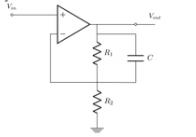6) The illustrated amplifier is a slight modification of a circuit that should be familiar to you. R What is the gain of the amplifier G for DC signals, i.e., when o → 0? b) What is the gain of the amplifier G for sinusoidal AC signals when o→ o? c) What is the gain of the amplifier G when o = 1/(R¡C)?
6) The illustrated amplifier is a slight modification of a circuit that should be familiar to you. R What is the gain of the amplifier G for DC signals, i.e., when o → 0? b) What is the gain of the amplifier G for sinusoidal AC signals when o→ o? c) What is the gain of the amplifier G when o = 1/(R¡C)?
Related questions
Question
100%

Transcribed Image Text:6) The illustrated amplifier is a slight modification of a circuit that should be familiar to
you.
Vin
а)
What is the gain of the amplifier G for DC signals, i.e., when o → 0?
b)
What is the gain of the amplifier G for sinusoidal AC signals when o → o0?
c)
What is the gain of the amplifier G when o = 1/(RỊC)?
Expert Solution
Step 1
(a)
Given:
The circuit diagram is as follows:

Introduction:
A non-inverting amplifier is an op-amp circuit configuration that produces an amplified output signal. This output signal of the non-inverting op-amp is in-phase with the input signal applied. In other words, a non-inverting amplifier behaves like a voltage follower circuit.
Trending now
This is a popular solution!
Step by step
Solved in 2 steps with 1 images
